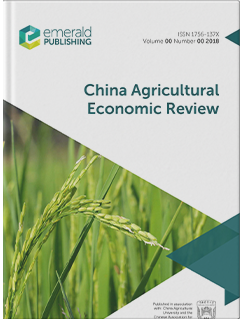Identification of urban-rural integration types in China – an unsupervised machine learning approach
IF 4.6
2区 经济学
Q1 AGRICULTURAL ECONOMICS & POLICY
引用次数: 2
Abstract
PurposeDevelopment of urban-rural integration is essential to fulfill sustainable development goals worldwide, and comprehension about urban-rural integration types has been highlighted as increasingly relevant for an efficient policy design. This paper aims to utilize an unsupervised machine learning approach to identify urban-rural integration typologies based on multidimensional metrics regarding economic, population and social integration in China.Design/methodology/approachThe study introduces partitioning around medoids (PAM) for the identification of urban-rural integration typologies. PAM is a powerful tool for clustering multidimensional data. It identifies clusters by the representative objects called medoids and can be used with arbitrary distance, which help make clustering results more stable and less susceptible to outliers.FindingsThe study identifies four clusters: high-level urban-rural integration, urban-rural integration in transition, low-level urban-rural integration and early urban-rural integration in backward stage, showing different characteristics. Based on the clustering results, the study finds continuous improvement in urban-rural integration development in China which is reflected by the changes in the predominate type. However, the development still presents significant regional disparities which is characterized by leading in the east regions and lagging in the western and central regions. Besides, achievement in urban-rural integration varies significantly across provinces.Practical implicationsThe machine learning techniques could identify urban-rural integration typologies in a multidimensional and objective way, and help formulate and implement targeted strategies and regionally adapted policies to boost urban-rural integration.Originality/valueThis is the first paper to use an unsupervised machine learning approach with PAM for the identification of urban-rural integration typologies from a multidimensional perspective. The authors confirm the advantages of this machine learning techniques in identifying urban-rural integration types, compared to a single indicator.中国城乡一体化类型识别——一种无监督机器学习方法
目的城乡一体化的发展是实现全球可持续发展目标的必要条件,对城乡一体化类型的理解对于有效的政策设计越来越重要。本文旨在利用无监督机器学习方法,基于中国经济、人口和社会一体化的多维指标,识别城乡一体化类型。设计/方法/方法本研究引入了围绕媒介的划分(PAM)来识别城乡一体化类型。PAM是聚类多维数据的强大工具。它通过称为介质的代表性对象来识别聚类,并且可以使用任意距离,这有助于使聚类结果更稳定,更不容易受到异常值的影响。研究发现:城乡一体化水平高、转型阶段城乡一体化、低水平城乡一体化和早期城乡一体化落后阶段四个集群呈现出不同的特征。在聚类结果的基础上,研究发现中国城乡一体化发展持续提升,主要表现在优势类型的变化上。但发展仍存在明显的地区差异,呈现出东部领先、中西部滞后的特点。此外,城乡一体化的成果在各省之间存在显著差异。实践意义机器学习技术可以多维、客观地识别城乡一体化类型,有助于制定和实施有针对性的城乡一体化战略和区域适应政策。原创性/价值这是第一篇使用无监督机器学习方法和PAM从多维角度识别城乡一体化类型的论文。与单一指标相比,作者证实了这种机器学习技术在识别城乡一体化类型方面的优势。
本文章由计算机程序翻译,如有差异,请以英文原文为准。
求助全文
约1分钟内获得全文
求助全文
来源期刊

China Agricultural Economic Review
AGRICULTURAL ECONOMICS & POLICY-
CiteScore
9.80
自引率
5.90%
发文量
41
审稿时长
>12 weeks
期刊介绍:
Published in association with China Agricultural University and the Chinese Association for Agricultural Economics, China Agricultural Economic Review publishes academic writings by international scholars, and particularly encourages empirical work that can be replicated and extended by others; and research articles that employ econometric and statistical hypothesis testing, optimization and simulation models. The journal aims to publish research which can be applied to China’s agricultural and rural policy-making process, the development of the agricultural economics discipline and to developing countries hoping to learn from China’s agricultural and rural development.
 求助内容:
求助内容: 应助结果提醒方式:
应助结果提醒方式:


